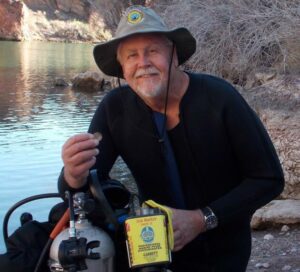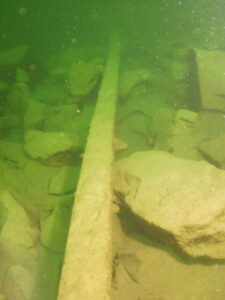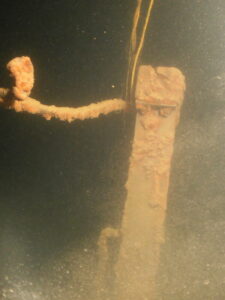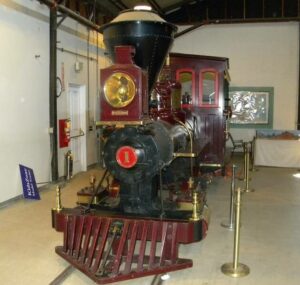Lost Tales: A sunken train in Idaho may solve a century-old mystery

Lost tales and mysteries come in a great variety. They may be located on the other side of the world, or just down the street, on top of a mountain or deep below the sea. One of the strangest tales was found in the depths of a mountain lake in the pine-covered mountains of Idaho.
It began as a curious story, mere tidbits of information really, none of it verified or attributed, only that a train sank in Lake Pend Oreille, Idaho, probably in 1909. Clearly, it was going to take a little work to locate and photograph the enigmatic sunken train with so little to go on.
This is the first installment of a fascinating series of revolving around writer, diver, and explorer David Finnern.

To my good fortune, after numerous internet searches and communicating with various dive shops and technical divers in the area, I finally located the diver who had actually discovered the train. I drove the two days to Coeur D’ Alene, and true to his word, Rick, the discoverer of the train, picked me up at my hotel at the prearranged time. We drove north for about an hour, and then entered a beautiful wilderness setting adorned with countless pine trees and greenery. We suited-up near an antiquated bench, swam on the surface to our landmark on the bank, a tree with a broken branch, and then submerged. The conditions were fair. The water was a comfortable 67 degrees; water visibility was about 12’ with a distinct greenish hue. The only issue was a layer of fine silt that dusted the entire bottom. The slightest disturbance resulted in a massive brown cloud billowing upward, reducing visibility to near-zero.

As we submerged wreckage began appearing about 30’ deep. Some of it was clearly manmade, yet indistinct and unidentifiable. Then, at 50’ I saw a wire, which was later identified as old telegraph wire. We followed it downward and then scattered train tracks appeared, and then more wreckage, including a brass stanchion and other train parts strewn across the rocky bottom.
I continued downward, and was suddenly hit with a thermocline. I was expecting it, but that didn’t ease the discomfort as the water temperature abruptly plummeted to 46 degrees. Suddenly, a conspicuous coupling emerged out of the greenish-black haze at 95’. The coupling had once connected the cars and now stood upright as if a monument to the incident. The actual cars began appearing at 125’.
The dive had indeed proven an old train was beneath the lake’s surface. I mentally gathered all the information I could observe, and continued to soak in the incident as I swam on the surface back to the water’s edge.

Drawing a diagram of the site created a possible scenario of the accident. A dirt rail bed curved around a hillside about 10’ above the water. The train probably took the curve too fast, and crashed into the water, taking some of the tracks and telegraph wire with it. The larger train parts were in deeper water, hence farther away from the bank, so it’s possible the train was moving excessively fast when it derailed and literally flew through the air before landing on the water.
A railroad museum curator later confirmed the train parts photographed were indeed from a turn-of-the-century train, including the coupling which he identified as a “knuckle coupling” from the 1890s. Other wreckage was identified as likely from a Baldwin locomotive c. 1900.

Curiously, subsequent investigation revealed nothing more. The Idaho State archaeologist knew nothing of the incident. The State archivist searched Idaho newspaper stories 20 years on either side of the event, and found nothing. The local historical society knew nothing. The official railroad historian had never heard of it.
The obvious question remains: How does a train disappear and nobody notices? Surely, someone would notice that Aunt Mabel never arrived at the station. But that seems to be exactly what happened to the enigmatic train rusting below Lake Pend Oreille.
One possible explanation is that the train was a victim of The Great Fire of 1910. The cause of the fire was never determined, but due to an unusually dry winter and hot summer hundreds of fires ignited throughout Idaho, Montana, Washington and British Columbia. On August 20 hurricane-force winds combined the smaller fires into one conflagration of unprecedented size. Within two days 3,000,000 acres had been burned and 87 people were dead.
 Smoke from the fire could be seen as far away as New York. Even ships could not navigate offshore, as the smoke penetrated the Pacific out 500 miles.
Smoke from the fire could be seen as far away as New York. Even ships could not navigate offshore, as the smoke penetrated the Pacific out 500 miles.
It’s recorded that passenger trains began evacuating residents from threatened towns. One train carrying 1,000 people took refuge in a tunnel after racing across a burning trestle. Could the enigmatic sunken train be just another victim of The Great Fire of 1910? Could it be the engineer took the curve too quickly while trying to escape what is believed to be the largest fire in U.S. history? While the timing is correct, there is no way of knowing, at least not yet. And then there’s the lack of available information. It may be that the incident was considered a minor footnote to a much greater story, and therefore went unreported. But for now, the train rests peacefully and unexplained deep below Lake Pend Oreille, one of the countless lost tales and mysteries in America.
–Award-winning adventure writer David Finnern has published hundreds of stories about his underwater discoveries and explorations which have regaled the pages of books, magazines and newspapers for over 35 years. His newest book series follow Christian adventurer Capt. Roy Henry and his nephew in the novels Beneath Black Water Cove and The Lost Flight, available through Amazon and book sellers everywhere.
Metro Voice is an Amazon Associate. Your browsing supports our efforts:






